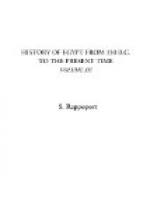Thus in a brief period Muhammedanism spread from the Nile Valley to the Mediterranean. Muhammed’s trenchant argument was the sword. He gave a distinct command to his followers to convince the infidels of the Power of truth on the battle-field. “The sword is a surer argument than books,” he said. Accordingly the Koran ordered war against unbelievers: “The sword is the key to heaven and hell; a drop of blood shed in the cause of Allah, a night spent in arms, is of more avail than two months of fasting and prayer; whoever falls in battle, his sins are forgiven, and at the day of judgment his limbs shall be supplied with the wings of angels and cherubim.” Before the battle commenced, the commanders reminded the warriors of the beautiful celestial houris who awaited the heroes slain in battle at the gates of Paradise.
The first efforts having been crowned with success, the Moslems soon became convinced of the fulfilment of the prophecy that Allah had given them the world and wished them to subdue all unbelievers. Under the Caliph Omar, the Arabs had become a religious-political community of warriors, whose mission it was to conquer and plunder all civilised and cultured lands and to unfurl the banner of the crescent. They believed that “Paradise is under the shadow of the sword.” In this belief the followers of Muhammed engaged in battle without fear or anxiety, spurred to great deeds, reckless in the face of danger, happy to die and pass to the delights of Paradise. The “holy war” became an armed propaganda pleasing to Allah. It was, however, a form of propaganda quite unknown and amazing to Christendom. In the course of two centuries the crescent had supplanted the cross. Of what avail was the peaceful missionary’s preaching if province after province and country after country were taken possession of by the new religion that forced its way by means of fire and sword?
Was it not natural that Christian Europe should conceive the idea of doing for their religion what the Moslems did for Islam! and that, following the example of Moslems in their “holy war,” Christians should emulate them in the Crusades?
It must not be forgotten also that the Arabs, almost from the first appearance of Muhammedanism, were under the refining and elevating influences of art and science. While the rest of Europe was in the midnight of the Dark Ages, the Moorish universities of Spain were the beacon of the revival of learning. The Christian teacher was still manipulating the bones of the saints when the Arab physician was practising surgery. The monachal schools and monasteries in Italy, France, and Germany were still grappling with poor scholastic knowledge when Arab scholars were well advanced in the study of Aristotle and Plato. Stimulated by their acquaintance with the works of Ptolemy and Euclid, Galenus and Hippocrates, they extended their researches into the dominions of astronomy, mathematics, and medicine.




